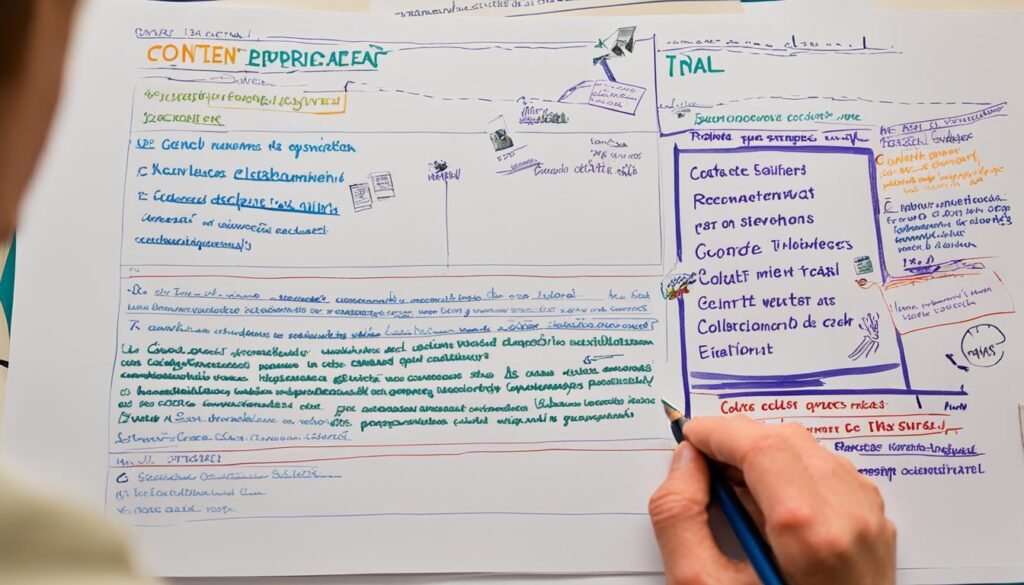Welcome to our comprehensive guide on understanding editorial policies in scientific publishing. In this article, we will explore the crucial guidelines and best practices that shape the process of reviewing and publishing scientific reports. From the role of the reviewer to considerations of authorship, plagiarism, and conflicts of interest, we will provide you with valuable insights into the world of scientific publishing. So, let’s dive in and unravel the intricacies of navigating editorial policies!
Key Takeaways:
- Editorial policies play a vital role in maintaining the integrity and quality of scientific publications.
- The peer review process involves the evaluation of scientific reports by qualified reviewers.
- Authorship guidelines define the criteria for listing authors and acknowledging contributions to the study.
- Plagiarism and conflicts of interest must be addressed to ensure accuracy and ethical research practices.
- The editorial process involves several stages, from manuscript submission to publication.
The Role of the Reviewer in Editorial Policies
In the world of scientific publishing, the role of the reviewer is of utmost importance. Reviewers play a critical role in upholding the integrity and quality of scholarly publications. They are responsible for evaluating manuscripts through the process of peer review, providing valuable feedback to authors and ensuring that the published work meets the standards set by the journal’s editorial board.
Peer review is a rigorous evaluation process in which experts in the field critically assess the submitted manuscripts. It serves as a quality control mechanism and ensures that only robust and scientifically sound research gets published. Reviewers analyze the validity, significance, and originality of the research, offering constructive feedback to authors to enhance their work.
“The peer review process plays a crucial role in maintaining the credibility of scientific publications.”
In addition to evaluating the scientific content, reviewers also play a vital role in identifying any corrections that may be necessary. If errors or inaccuracies are found in a published article, it is the responsibility of the reviewer to bring them to the attention of the editorial board. This ensures that any necessary corrections are made promptly, maintaining the credibility of the publication and the scientific record.
Retractions are infrequent occurrences, but they are essential in cases where significant errors or misconduct have been identified in published articles. Reviewers, as well as other readers, have a crucial role in identifying such issues and informing the editorial board. Retractions are necessary to safeguard the integrity and trustworthiness of the scientific literature.
The editorial board plays a key role in shaping the policies and practices of the journal. They are responsible for selecting reviewers, making editorial decisions, and upholding the publication’s standards. The board comprises experts in various fields who collectively contribute to maintaining the quality and integrity of the journal.
The Peer Review Process
The peer review process typically begins with the submission of a manuscript by the authors. The editor then assigns the manuscript to reviewers who possess the necessary expertise to evaluate the research. Reviewers carefully analyze the manuscript, assessing its originality, methodology, results, and conclusions. They provide detailed feedback to the authors, which helps improve the quality of the research and its presentation.
The process may involve multiple rounds of review and revision, allowing for a thorough evaluation of the work. It is important to note that the identities of reviewers are often kept anonymous to encourage unbiased assessments and honest feedback.
The reviewer’s contributions are vital in maintaining the integrity and rigor of scientific publishing. Their expertise and dedication to the peer review process help ensure that only high-quality research makes its way into the scientific literature.
Guidelines for Authorship in Scientific Reports
Authorship in scientific reports is a critical aspect of academic publishing. It not only recognizes the contributors to a study but also ensures transparency and accountability within the scientific community. In this section, we will discuss important guidelines and best practices for authorship in scientific reports, covering the review process, manuscript submission, criteria for authorship, listing authors, and acknowledging contributions to the study.
Review Process and Submitted Manuscript
Before a scientific report is published, it undergoes a rigorous review process to ensure its quality and validity. During this process, the submitted manuscript is carefully evaluated by experts in the field, known as peer reviewers. These reviewers assess the study’s methodology, data analysis, and conclusions to determine its suitability for publication.
Criteria for Authorship
Authorship in scientific reports should be based on substantial contributions to the study. Each author is expected to have made significant intellectual contributions to the conception, design, execution, or interpretation of the research. Merely providing funding, data collection, or general supervision does not typically qualify an individual for authorship.
“Authorship, while important for recognition, also comes with ethical responsibilities. All authors should ensure the accuracy and integrity of any part of the published article related to their contribution.”
Listing Authors and Contribution to the Study
When listing authors in a scientific report, it is essential to accurately reflect each individual’s contributions to the study. The order of authorship should be determined through discussion and agreement among the authors, considering their level of contribution and expertise. It is common to list the authors in descending order of their contributions.
Acknowledging Contributions to the Study
It is also important to acknowledge the contributions of individuals who did not meet the criteria for authorship but still played a significant role in the research. These contributions may include technical support, data analysis, or critical review of the manuscript. Such individuals should be acknowledged in the acknowledgments section of the scientific report.
By following these guidelines for authorship, scientific reports can accurately recognize the contributions of researchers, maintain research integrity, and foster collaboration within the scientific community.
Ensuring Accuracy and Integrity: Plagiarism and Conflict of Interest
Ensuring accuracy and integrity in scientific reports is paramount to maintaining the credibility of research. Two key areas that require careful attention are plagiarism and conflicts of interest.
Plagiarism
Plagiarism, the act of presenting someone else’s work or ideas as one’s own, is a serious ethical breach in scientific publishing. It compromises the originality and integrity of the research, misleading readers and eroding trust within the scientific community.
Scientists must always strive to properly attribute and cite the work of others. Plagiarism detection tools are becoming increasingly sophisticated, making it crucial for authors to be diligent in their citation practices. By upholding the principles of academic honesty, researchers safeguard the integrity of their own work and contribute to the advancement of knowledge.
Conflicts of Interest
Conflicts of interest can arise when personal, professional, or financial considerations influence the research process or the interpretation of results. These conflicts may compromise objectivity, introduce bias, and undermine the credibility of the findings.
To promote transparency and trust, researchers should fully disclose any potential conflicts of interest related to their study. Journals often require authors to declare conflicts of interest, as it is important for readers to be aware of any potential biases that could impact the interpretation of the research.
Data Sharing and Integrity
Ensuring the accuracy and integrity of any data presented in scientific reports is crucial for research reproducibility and verification. Transparent data sharing allows other researchers to evaluate and build upon existing work, fostering scientific progress.
Furthermore, adherence to ethical standards such as the Declaration of Helsinki and oversight by Institutional Review Boards (IRBs) reinforces the commitment to upholding the welfare and rights of participants involved in studies.
By promoting data sharing, researchers contribute to the collective knowledge and demonstrate their commitment to scientific integrity.
Overall, to maintain the highest standards in scientific research, it is vital to address issues related to plagiarism, conflicts of interest, data sharing, and the integrity of any part of scientific reports.

The Editorial Process: From Submission to Publication
Once a manuscript has been carefully prepared and reviewed by the authors, it is time to navigate the editorial process that leads to its publication. This section will provide an insightful overview of the various stages involved in transforming a submitted manuscript into a published article. From adhering to editorial guidelines to understanding the intricacies of editorial decision-making, each step plays a crucial role in ensuring the integrity and quality of scientific reports.
Editorial Guidelines:
Before submitting a manuscript, authors should familiarize themselves with the editorial guidelines of the target journal. These guidelines outline formatting requirements, citation styles, and ethical considerations that authors must adhere to. It is essential to follow these guidelines meticulously to increase the likelihood of acceptance for publication.
The Review Process:
After a manuscript is submitted, it undergoes a rigorous review process designed to evaluate its scientific merits, methodology, and overall quality. Reviewers who are experts in the field provide valuable feedback and recommendations to the authors. This critical evaluation helps authors refine their work to meet the highest standards of scientific reporting.
Acceptance for Publication:
Upon completion of the review process, the editorial decision-making plays a crucial role. Based on the evaluations and recommendations of the reviewers, the journal’s editorial team decides whether to accept the manuscript for publication. This decision takes into account factors such as the manuscript’s novelty, scientific rigor, and contribution to the field.
Post-publication Considerations:
Once a manuscript is accepted for publication, it enters the post-publication phase. During this stage, the manuscript undergoes copyediting and proofreading to ensure accuracy, clarity, and consistency in language and formatting. The final version is then published either online or in print, making it accessible to the scientific community and the wider public.
Understanding the editorial process is crucial for authors seeking to contribute to the scientific discourse. By navigating the submission, review, acceptance, and post-publication stages effectively, authors can increase their chances of successfully sharing their research findings with the world.

Compliance with Ethical Standards: Informed Consent and Data Sharing
When it comes to scientific research, it is imperative to adhere to ethical standards to ensure the protection of human subjects and promote transparency. Two crucial aspects of ethical compliance are obtaining informed consent and facilitating data sharing. Let’s explore these topics in further detail.
Informed Consent
In studies involving human subjects, obtaining informed consent is a fundamental ethical requirement. Informed consent ensures that individuals fully understand the nature, purpose, risks, and potential benefits of participating in research before they agree to do so.
Researchers should provide clear and comprehensive information about the study to potential participants, enabling them to make an informed decision. This includes details about the purpose of the study, procedures involved, risks, potential benefits, confidentiality measures, and their right to withdraw at any time without consequence.
Institutional Review Boards (IRBs) play a crucial role in reviewing and approving research protocols to ensure that the informed consent process meets ethical standards. IRBs conduct thorough evaluations to safeguard the rights and welfare of human subjects, evaluating the adequacy of the consent forms and procedures.
By obtaining informed consent, researchers demonstrate their commitment to respecting individual autonomy and upholding the principles of ethical research.
Data Sharing
Data sharing is a core principle in scientific research, promoting transparency, reproducibility, and collaboration. It involves making research data and findings available to the scientific community and the public, ensuring that the knowledge generated can be scrutinized, replicated, and built upon.
Sharing data allows for independent verification and validation of research findings, enhancing the scientific process. It enables other researchers to explore new hypotheses, conduct meta-analyses, and identify potential errors or biases in the original study.
Furthermore, data sharing facilitates interdisciplinary collaborations and accelerates scientific progress by avoiding unnecessary duplication of efforts. This collaborative approach fosters innovation, drives breakthroughs, and maximizes the value of research investments.
However, while data sharing is encouraged, it must be done responsibly and in compliance with legal and ethical frameworks. Researchers should consider factors such as privacy, confidentiality, intellectual property rights, and potential harm to participants when determining the extent to which data can be shared.
In addition to fostering public trust, responsible data sharing is often a requirement of funding sources and journals. Many funding agencies have policies that mandate sharing research data with the broader scientific community, ensuring the long-term impact of research investments.
Overall, compliance with ethical standards, including obtaining informed consent and facilitating data sharing, is paramount for upholding the integrity and trustworthiness of scientific research.

Open Access and Editorial Independence
In the ever-evolving landscape of scientific publishing, open access has emerged as an influential concept, shaping the way research is disseminated and accessed worldwide. Open access refers to the unrestricted availability of scholarly articles, enabling free and immediate access to knowledge for readers, regardless of their institutional affiliations. This approach fosters wider dissemination of research, promotes collaboration, and accelerates scientific progress.
However, the implementation of open access comes with its own set of considerations, particularly regarding editorial independence and the maintenance of high editorial standards. It is crucial for journals to strike a balance between providing open access to research and upholding rigorous peer review processes and editorial oversight.
The journal’s editorial team plays a vital role in ensuring the quality and integrity of published articles. They are responsible for upholding high editorial standards, including rigorous peer review, adherence to ethical guidelines, and compliance with publication ethics. By upholding these standards, journals can maintain their reputation and the trust of the scientific community, ensuring that only credible and reliable research is disseminated.
Furthermore, editorial independence is a cornerstone of scientific publishing. It ensures that the journal’s editorial decisions are not influenced by external factors, such as financial interests or political agendas. Editorial independence allows researchers to have confidence in the review and publication process, knowing that their work is evaluated solely on its scientific merit.
To further bolster editorial independence and maintain transparency, many journals rely on the guidance of international committees on publication ethics. These committees provide valuable insights and recommendations on editorial policies, ethical practices, and standards in scientific publishing.
Open access has revolutionized the accessibility of scientific research. However, it is crucial for journals to maintain their editorial independence and uphold high standards of publication ethics to ensure the credibility and reliability of the research being disseminated.
By adhering to stringent editorial standards, ensuring editorial independence, and seeking the guidance of international committees, journals can navigate the challenges and seize the opportunities presented by open access, ultimately contributing to the growth and development of the scientific community.

Ensuring Transparency: Reporting and Data Availability
In the world of scientific research, transparency plays a vital role in the integrity and credibility of publications. Reporting accurate and reliable data is essential to promote accountability and facilitate further analysis and reproducibility. This section focuses on key aspects related to reporting and data availability, including the use of original data, public repositories, clinical trials, dataset descriptions, and the importance of transparent practices.
The Availability of Original Data
Ensuring the availability of original data is fundamental in scientific reporting. By making the raw data accessible to the scientific community, researchers can verify and validate the findings presented in manuscripts, fostering transparency and advancing knowledge. Original data serves as a valuable resource for researchers who aim to build upon existing studies or conduct further analysis in related fields. It also allows for the identification of potential errors, inconsistencies, or the need for additional exploration.
Utilizing Public Repositories
Public repositories provide a centralized platform for storing and sharing datasets with the scientific community. By depositing data in public repositories, researchers contribute to collective knowledge and enable others to reproduce their results or perform new analyses. Public repositories also ensure long-term access to data, safeguarding it from loss or deterioration. Examples of well-established public repositories include GenBank for genomic data, the Protein Data Bank for structural data, and the Dryad Digital Repository for various types of research data.
Reporting of Clinical Trials
Clinical trials are a critical component of medical research and play a pivotal role in advancing healthcare practices. Transparent reporting of clinical trials is crucial for accurate interpretation and assessment of the study’s methodology, results, and potential impact. By adhering to established reporting standards, such as the Consolidated Standards of Reporting Trials (CONSORT), researchers ensure comprehensive and meaningful documentation of their clinical trial findings. This enables healthcare professionals and policymakers to make informed decisions based on reliable evidence.
Inclusion of Dataset Descriptions in the Manuscript
Another essential element of transparent reporting is the inclusion of dataset descriptions in the manuscript. By providing detailed information about the dataset used in the study, including its characteristics, variables, and any pre-processing steps, researchers enhance the reproducibility of their work. Dataset descriptions promote transparency by allowing other researchers to understand the basis of the analysis and reproduce the same results using the provided data.
Ensuring transparency in reporting and data availability enhances the integrity and credibility of scientific research. By utilizing original data, leveraging public repositories, adhering to reporting standards for clinical trials, and including comprehensive dataset descriptions in manuscripts, researchers foster trust and collaboration within the scientific community. These practices facilitate further exploration, reinforce the reproducibility of research, and ultimately contribute to the advancement of knowledge.

Best Practices for Content Creation and Policy Compliance
In order to uphold journalism and writing standards, it is essential to follow content guidelines, ensure policy compliance, and adhere to publishing rules. By incorporating content creation best practices, media organizations and journalists can maintain the highest levels of professionalism and ethical conduct. This section provides guidance on how to achieve these standards.
Journalism Standards and Writing Standards
Journalism standards encompass a set of ethical norms and principles that guide journalists in their professional conduct. These standards emphasize accuracy, fairness, objectivity, and accountability in reporting. It is crucial for journalists to verify information from reliable sources, corroborate facts, and provide comprehensive and balanced coverage of events.
Similarly, writing standards play a vital role in ensuring clear and concise communication. Journalists should use a consistent writing style, employ proper grammar and punctuation, and convey information effectively to their audience. Quality writing enhances readability and helps engage readers with the content.
Content Guidelines and Policy Compliance
Adhering to content guidelines is essential for maintaining the integrity and credibility of journalistic work. These guidelines outline specific requirements related to accuracy, sourcing, attribution, and responsible reporting. Journalists should rigorously follow these guidelines to produce truthful and reliable content.
Policy compliance involves conforming to legal and regulatory frameworks that govern media organizations. It encompasses a range of factors such as privacy laws, copyright regulations, and disclosure requirements. By adhering to these policies, media organizations can avoid legal issues and ensure transparency in their operations.
Publishing Rules and Content Creation Best Practices
Publishing rules govern the process of presenting and distributing content to the audience. They include formatting guidelines, editorial standards, and platform-specific requirements. Journalists should familiarize themselves with these rules to optimize the presentation and accessibility of their work.
Content creation best practices provide a framework for producing high-quality and engaging journalism. These practices emphasize storytelling techniques, effective use of visuals, and the incorporation of multimedia elements. By employing these best practices, journalists can enhance the impact and reach of their content.
Journalism standards, writing standards, content guidelines, policy compliance, and publishing rules are the pillars of professional journalism. By adhering to these practices, journalists can uphold the principles of accuracy, fairness, and accountability, while creating content that resonates with their audience.
To summarize, journalists must adhere to journalism and writing standards, follow content guidelines, ensure policy compliance, and adhere to publishing rules. By incorporating content creation best practices, journalists can produce high-quality, impactful content that aligns with industry standards and engages their audience effectively.
| Journalism Standards | Writing Standards | Content Guidelines | Policy Compliance | Publishing Rules | Content Creation Best Practices |
|---|---|---|---|---|---|
| Follow ethical norms and principles | Consistent writing style | Accurate and responsible reporting | Adhere to legal and regulatory frameworks | Comply with formatting and editorial standards | Utilize storytelling techniques and multimedia elements |
| Ensure accuracy, fairness, and objectivity | Use proper grammar and punctuation | Source information from reliable sources | Respect privacy laws and copyright regulations | Optimize presentation and accessibility | Engage audience with impactful content |
Repository and Reviewer Considerations
In the editorial process, repositories and reviewers play crucial roles in ensuring the transparency and quality of scientific reports. Let’s explore the significance of these considerations in more detail:
The Role of Repositories in Ensuring Transparency
Repositories serve as essential platforms for storing and sharing research data, promoting transparency, and facilitating future collaborations. By providing a centralized location where researchers can deposit and access data, repositories contribute to the reproducibility and credibility of scientific findings.
With the increasing emphasis on open science, many journals now require authors to deposit their datasets in repositories upon publication. This practice enables other researchers to validate and build upon the findings, fostering a culture of transparency and knowledge sharing.
Additionally, repositories often implement metadata standards and documentation requirements that help users understand the context and limitations of the deposited data. This ensures that the data can be effectively utilized and interpreted by the scientific community.
One notable example is the National Center for Biotechnology Information’s (NCBI) GenBank, a widely used repository for genetic sequence data. GenBank promotes transparency and collaboration by making data publicly available to support scientific research across various disciplines.
By embracing repositories and encouraging data sharing, journals and publishers contribute to the robustness and openness of the scientific enterprise.
The Importance of Reviewers’ Substantial Contributions
Reviewers play a pivotal role in the editorial decision-making process. Their insightful critique and evaluation of manuscripts contribute to the overall quality, accuracy, and novelty of scientific reports.
Reviewers provide constructive feedback on various aspects, including the methodology, data analysis, interpretation, and overall scientific merit of the study. Their expertise and critical assessment help identify any weaknesses, inconsistencies, or gaps in the research, leading to improvements and enhancing the integrity of the publication.
Reviewers’ expertise and dedication to the peer review process are vital for maintaining the high standards of scientific publishing. Their thorough evaluation ensures that only studies meeting the rigorous scientific criteria are published, upholding the reliability and credibility of the scientific literature.
Moreover, reviewers’ contributions go beyond evaluating manuscripts. They often provide valuable suggestions for further experiments or analyses that can enhance the study’s impact and scientific significance.
The Impact of Reviewers on Editorial Decision-Making
The insights and recommendations of reviewers substantially influence the editorial decisions made by journal editors. Editors rely on reviewers’ expertise and feedback to assess the quality and suitability of manuscripts for publication.
Based on reviewers’ evaluations, editors make informed decisions regarding manuscript acceptance, revision requests, or rejection. The careful consideration of reviewers’ comments ensures that the published reports are robust, accurate, and meet the journal’s standards of excellence.
Journal editors also rely on reviewers’ feedback to make decisions on specific aspects of the manuscript, such as the need for additional experiments or the suitability of the study for the journal’s target audience.
Also Read:- Exploring The Depths: What Is Scientific Inquiry?
In summary, repositories and reviewers play crucial roles in the editorial process. Repositories ensure transparency through data sharing and documentation, while reviewers provide substantial contributions to improve the quality and integrity of scientific reports. Their combined efforts contribute to the advancement of scientific knowledge and the credibility of the research community.
Conclusion
Understanding and navigating editorial policies is essential in the field of scientific publishing. This article has highlighted key considerations such as the role of the reviewer, authorship guidelines, ensuring accuracy and integrity, the editorial process, compliance with ethical standards, open access, transparency in reporting, best practices for content creation, and the importance of repositories and reviewers.
By adhering to ethical and transparent practices, researchers and authors can contribute to the credibility and integrity of scientific reports. The peer review process, correction and retractions, and compliance with guidelines and standards all play crucial roles in ensuring the quality of published work.
Furthermore, maintaining open access and editorial independence supports the free flow of information and the advancement of knowledge. Transparency in reporting and the availability of original data contribute to the reproducibility and reliability of research findings. Following content creation best practices and policy compliance are essential for creating high-quality and trustworthy scientific reports.
In conclusion, a thorough understanding of editorial policies and compliance with ethical and transparent practices are key to successful scientific publishing. By following these guidelines, researchers and authors can contribute to the advancement of their respective fields and ensure the dissemination of reliable and impactful scientific reports.
FAQs
What are editorial policies?
Editorial policies are guidelines and rules established by scientific journals to ensure the integrity, transparency, and ethical conduct of the publishing process.
What is the role of a reviewer in the editorial process?
Reviewers play a crucial role in the editorial process by evaluating the quality, validity, and significance of submitted manuscripts. They provide feedback and recommendations to the journal editor to help in the decision-making process.
How does the peer review process work?
The peer review process involves independent experts reviewing a manuscript to assess its quality, validity, and significance. Reviewers provide feedback, recommendations, and critique to the author and the journal editor.
What should authors consider when submitting a manuscript?
Authors should carefully follow the journal’s submission guidelines, ensure the manuscript meets the criteria for original research, and provide all necessary details and documentation required for consideration.
What are the criteria for authorship in scientific reports?
Authorship in scientific reports is based on substantial contributions to the study, including the conception and design, data collection and analysis, and interpretation of the findings. All listed authors must have made a significant intellectual contribution to the work.
How should authors list authors in a published article?
Authors should accurately list all individuals who have made substantial contributions to the study. Each author’s role and contribution should be clearly described in the acknowledgments section of the article.
How should contributions to the study be acknowledged?
Contributions to the study that do not meet the criteria for authorship should be acknowledged in the acknowledgments section of the article. This includes individuals who provided technical assistance, data collection, or funding support.
What measures are in place to ensure the accuracy and integrity of scientific reports?
Scientific journals follow strict policies to address concerns related to plagiarism, conflicts of interest, and the integrity of any part of the work. Reviewers, editorial boards, and institutional review boards play a role in investigating and addressing such concerns.
What is the declaration of Helsinki?
The declaration of Helsinki is an ethical guideline for research involving human subjects. It outlines principles for informed consent, confidentiality, and the rights and welfare of research participants.
What is the role of institutional review boards in ethical research?
Institutional review boards ensure that studies involving human subjects meet ethical standards and comply with relevant regulations. They review research protocols, assess risks and benefits, and ensure informed consent is obtained.
What is the editorial process from submission to publication?
The editorial process involves the submission of a manuscript, review by independent experts, editorial decision-making based on reviewer feedback, acceptance for publication, and eventual post-publication considerations.
What are the best practices for content creation and policy compliance?
Best practices include adhering to journalism and writing standards, following content guidelines, ensuring policy compliance, and understanding publishing rules and content creation best practices.
What is open access and its impact on editorial independence?
Open access refers to unrestricted access to published content. It can impact editorial independence by allowing wider dissemination of research but also requires adherence to editorial standards and guidelines set by the journal’s editorial team.
How can transparency be ensured in scientific reporting?
Transparency can be ensured by making original data available, using public repositories for data sharing, reporting details of clinical trials, and including dataset descriptions within the manuscript.
What are the considerations for repositories and reviewers in the editorial process?
Repositories play a role in ensuring transparency by providing access to original data. Reviewers contribute to editorial decision-making by providing substantial feedback and recommendations based on their expertise in the respective fields.
What is the importance of navigating editorial policies in scientific publishing?
Navigating editorial policies is crucial to ensure the integrity, transparency, and ethical conduct of scientific publishing. Adhering to these policies is essential for the credibility and validity of scientific reports.
Source Links
- https://www.nature.com/nature/for-authors/formatting-guide
- https://www.councilscienceeditors.org/2-2-authorship-and-authorship-responsibilities
- https://www.ncbi.nlm.nih.gov/pmc/about/guidelines/

